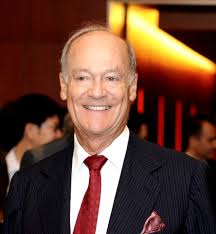Prince Amyn Mohamed Aga Khan Speaking at Zamana Gallery-1989-01-26
Zamana Gallery
On 26 January, 1989, Prince Amyn Mohammed, A Director of the Aga Khan Trust for Culture, opened the most important exhibition of Islamic calligraphy to be seen in London for many years.
The exhibition at the Zamana Gallery was entitled : Islamic Calligraphy : Sacred and Secular Writings, and contained many rare and beautiful examples dating back over the past one thousand years, drawn from Spain, Egypt, Turkey, Iran, India and Africa and consisting of works sent by galleries and from private collections.
The exhibition, which has already received much acclaim in Geneva and Dublin, will transfer after closing in London on 26th March, 1989 to Zurich and will move to Amman later in the year.
Speaking at the opening, Prince Amyn Mohammed said that of all art forms " Calligraphy holds pride of place as the foremost and perhaps most characteristic of the modes of visual expression in Islam." The tradition of calligraphy "started with the earliest written versions of the Quran in the mid-seventh century," said Prince Amyn Mohammed, "gained speed between the ninth and tenth centuries, when Arabic calligraphy entered a more codified form, knew a slight decline with the spread of printing throughout the Muslim world, but basically enjoyed ten centuries of uninterrupted growth and splendour. It is a tradition which still endures today among Muslims scattered across the far reaches of the globe."
"Script is a binding artistic and visual medium between Muslims, through the Quran and also between the various peoples and minorities forming the Muslim Umma. It thus constitutes a formal expression of Islam's universality and of its universal aspirations," said Prince Amyn Mohammed.
"It is particularly appropriate that this exhibition should open in London whose role in researching, in understanding and in bringing to international attention, the arts of non-Western cultures has for so many centuries been so great," He conclude.
The Zamana Gallery, dedicated to presenting the arts, architecture and culture of the developing world and more particularly the Islamic world, was established in 1985 by Mowlana Hazar Imam. The Gallery falls under the auspices of the Aga Khan Trust for Culture, which promotes and focuses attention on contemporary expressions of the Islamic humanistic tradition. The Trust concentrates particularly on the architecture and the planning of the build environment and assists those responsible for shaping its future.
Among the Trust's other activities are the triennial Aga Khan Award for Architecture which permeates outstanding architectural projects as well as organizing international seminars and maintaining a documentation centre, and the Aga Khan Program for Islamic Architecture at Harvard University and the Massachusetts Institute of Technology, which supports a joint programme leading to a Masters Degree in Design for Islamic Societies. The Trust also sponsors an urban housing programme at Harvard and the publication of MIMAR, a quarterly journal featuring architecture in development.
- 6817 reads
 Ismaili.NET - Heritage F.I.E.L.D.
Ismaili.NET - Heritage F.I.E.L.D.